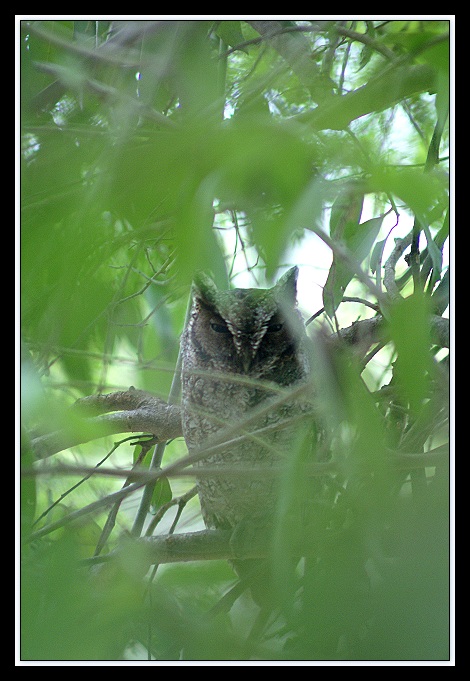(include statement) |
(habitat, behav, id, remove {{incomplete}}) |
||
| Line 1: | Line 1: | ||
| − | |||
[[Image:West-Peruvian_Screech-Owl.jpg|thumb|550px|right|Photo by mmdnje<br />Location: Agua Blanca, Machalilla Park, [[Ecuador]]]] | [[Image:West-Peruvian_Screech-Owl.jpg|thumb|550px|right|Photo by mmdnje<br />Location: Agua Blanca, Machalilla Park, [[Ecuador]]]] | ||
'''Alternative name: Peruvian Screech-Owl''';''' includes Tumbes Screech Owl''' | '''Alternative name: Peruvian Screech-Owl''';''' includes Tumbes Screech Owl''' | ||
| Line 5: | Line 4: | ||
''Otus roboratus'' | ''Otus roboratus'' | ||
==Identification== | ==Identification== | ||
| + | Grey and red morphs exist of both subspecies. | ||
| + | ====Variation==== | ||
| + | The ''pacificus'' subspecies is smaller (18-19 cm vs 20-22 for nominate subspecies) and shorter-tailed. | ||
==Distribution== | ==Distribution== | ||
Southern [[Ecuador]] and north-western [[Peru]]. | Southern [[Ecuador]] and north-western [[Peru]]. | ||
| Line 12: | Line 14: | ||
This species is divided into two subspecies, ''pacificus'' on the western side of the Andes, and ''roboratus'' between western and central Andes. These two subspecies have sometimes been considered two separate species: Tumbes Screech Owl (''Megascops pacificus'') and West Peruvian Screech-Owl (''Megascops roboratus''). | This species is divided into two subspecies, ''pacificus'' on the western side of the Andes, and ''roboratus'' between western and central Andes. These two subspecies have sometimes been considered two separate species: Tumbes Screech Owl (''Megascops pacificus'') and West Peruvian Screech-Owl (''Megascops roboratus''). | ||
==Habitat== | ==Habitat== | ||
| − | Semi-open landscapes with hollow old trees. | + | Semi-open landscapes with hollow old trees, mostly in dry woodland. |
==Behaviour== | ==Behaviour== | ||
| − | The diet | + | The diet mainly to be insects. It may also eat reptiles, small mammals such as bats and mice and other small birds. |
| + | |||
| + | Breeding probably in hole in tree. | ||
==References== | ==References== | ||
#{{Ref-Clements6thAug13}}# König, C. and F. Weick 2008. Owls of the World, second edition. Christopher Helm, London. ISBN 978-0-7136-6548-2 | #{{Ref-Clements6thAug13}}# König, C. and F. Weick 2008. Owls of the World, second edition. Christopher Helm, London. ISBN 978-0-7136-6548-2 | ||
Revision as of 02:47, 20 July 2014
Alternative name: Peruvian Screech-Owl; includes Tumbes Screech Owl
- Megascops roboratus
Otus roboratus
Identification
Grey and red morphs exist of both subspecies.
Variation
The pacificus subspecies is smaller (18-19 cm vs 20-22 for nominate subspecies) and shorter-tailed.
Distribution
Southern Ecuador and north-western Peru.
Taxonomy
This and almost all Screech Owls in the Americas have previously been considered to belong in the same genus (Otus) as the European and Asian Scops-Owls, but a reassignment to Megascops have been accepted by among other authorities, the American Ornithologists' Union.
This species is divided into two subspecies, pacificus on the western side of the Andes, and roboratus between western and central Andes. These two subspecies have sometimes been considered two separate species: Tumbes Screech Owl (Megascops pacificus) and West Peruvian Screech-Owl (Megascops roboratus).
Habitat
Semi-open landscapes with hollow old trees, mostly in dry woodland.
Behaviour
The diet mainly to be insects. It may also eat reptiles, small mammals such as bats and mice and other small birds.
Breeding probably in hole in tree.
References
- Clements, J. F., T. S. Schulenberg, M. J. Iliff, B.L. Sullivan, C. L. Wood, and D. Roberson. 2013. The eBird/Clements checklist of birds of the world: Version 6.8., with updates to August 2013. Downloaded from http://www.birds.cornell.edu/clementschecklist/download/
- König, C. and F. Weick 2008. Owls of the World, second edition. Christopher Helm, London. ISBN 978-0-7136-6548-2
Recommended Citation
- BirdForum Opus contributors. (2024) Peruvian Screech-Owl. In: BirdForum, the forum for wild birds and birding. Retrieved 29 April 2024 from https://www.birdforum.net/opus/Peruvian_Screech-Owl




